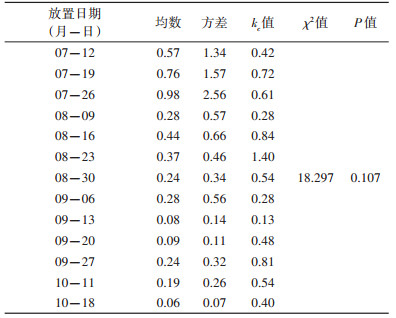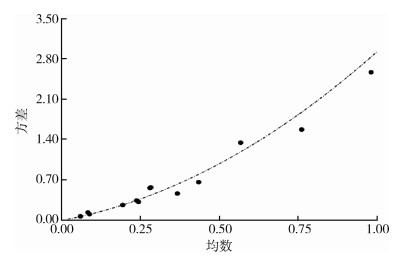扩展功能
文章信息
- 许峰, 王唐, 宋灿磊, 周毅彬
- XU Feng, WANG Tang, SONG Can-lei, ZHOU Yi-bin
- 诱蚊诱卵器捕获白纹伊蚊成蚊聚集趋势及分布型的研究
- Aggregation tendency and distribution pattern of adult Aedes albopictus mosquitoes captured by mosquito ovitraps
- 中国媒介生物学及控制杂志, 2021, 32(4): 481-486
- Chin J Vector Biol & Control, 2021, 32(4): 481-486
- 10.11853/j.issn.1003.8280.2021.04.020
-
文章历史
- 收稿日期: 2020-11-19
2 上海市疾病预防控制中心传染病防治所, 上海 200336
2 Institute of Infectious Disease Control, Shanghai Center for Disease Control and Prevention, Shanghai 200336, China
诱蚊诱卵器由林立丰[1]根据白纹伊蚊(Aedes albopictus)生态特点,结合美国疾病预防控制中心(CDC)诱卵器的诱卵原理和捕蝇笼捕蝇结构特点设计而成。诱蚊诱卵器监测时回收诱卵器中有伊蚊成蚊和/或伊蚊卵粒的为阳性[2]。诱蚊诱卵指数与布雷图指数相接近[3],在我国广泛应用于白纹伊蚊种群密度的监测。诱蚊诱卵器有较好的捕获产卵白纹伊蚊的能力和特点[4],捕获的成蚊在检测其带病毒指数方面具有较大的应用价值[5]。但目前对诱蚊诱卵器捕获成蚊的其他应用和研究尚未见报道,因此我们开展诱蚊诱卵器捕获白纹伊蚊成蚊聚集趋势及分布型的研究,为诱蚊诱卵器捕获白纹伊蚊成蚊数用于白纹伊蚊分布规律、生态学研究以及伊蚊密度监测提供理论基础。
1 材料与方法 1.1 研究区域本次研究区域位于上海市的金山区(图 1)。从金山区朱泾、廊下和亭林镇按照不同自然环境情况分别选择1个居民小区(占地面积 > 10 000 m2,居住户数 > 600户)。朱泾和廊下镇每次放置60个诱蚊诱卵器,亭林镇放置50个诱蚊诱卵器。

|
| 图 1 上海市金山区诱蚊诱卵器捕获白纹伊蚊成蚊研究区域及监测点位置 Figure 1 Study area and surveillance sites of adult Aedes albopictus mosquitoes captured by mosquito ovitraps in Jinshan district of Shanghai |
| |
2020年7月12日至10月18日,每周日放置诱蚊诱卵器,于周三回收。主要布放在居民区的外环境树木、花草、灌木丛等公共绿化带,每隔20 m布放1个诱蚊诱卵器,使用时在诱蚊诱卵器内倒入约20 ml脱氯水,并放入1张滤纸提供白纹伊蚊的产卵环境。遗失和破损的诱蚊诱卵器,判定为无效诱卵器。回收的诱蚊诱卵器内的白纹伊蚊雌成蚊计数。2020年8月2日放置的诱蚊诱卵器遗失30个,不计入统计结果,最终共计放置的13次诱蚊诱卵器数据用于数据分析。
1.3 统计学分析采用Excel 2016软件汇总数据,采用Stata 14.0软件进行统计分析。正态性检验使用Skewness/Kurtosis检验,用χ2检验对负二项分布参数k值进行拟合优度检验,P < 0.05为差异有统计学意义。
1.3.1 负二项分布的拟合优度检验负二项分布的概率质量函数为:

|
表示已知一个事件在伯努利试验中每次的出现概率是π,在一连串伯努利试验中,一件事件刚好在第r+k次试验出现第r次的概率。先使用最大似然法计算负二项分布参数k值,然后用χ2检验对计算的负二项分布参数k值进行拟合优度检验[6]。
负二项分布的概率表达式为:

|
(1) |
式中,k > 0,0 < π < 1。
先使用最大似然法计算负二项分布参数k值,即指能够使公式(2)中的z=0的k值即为所求。

|
(2) |
式中,m=Xmax为样本计数X所取得到的最大值;

|
(3) |
式中,AX为样本中所有计数大于X的样本的频数之和。采用线性内插法求得其估计值


|
(4) |
用χ2检验对最大似然法计算负二项分布参数k值进行拟合优度检验。令:

|
(5) |

|
(6) |
由于负二项分布中:

|
(7) |

|
(8) |
将公式(5)~(8)代入,公式(1)则等价于:

|
(9) |
其中均数X和方差S2分别作为负二项分布的均数μ和方差σ2的估计值。将上述计算的k、p、q代入公式(9)得到负二项分布各组的理论频率P(X),并以此公式计算各组捕获蚊虫数的理论频数。其中理论频数 < 5的组,进行合并计算。利用χ2检验对实际频数和理论频数进行比较,其自由度为理论频数合并后组数减去3。
1.3.2 公共kc值的计算使用矩法中的加权估计法[7]。分别将每次监测的数据作为1组,共有13组数据,估计其可能的公共kc值。
每组资料的分布中ki用矩估计值法,即:

|
(10) |
式中,x为每组样本均数,S2为每组样本方差。令:

|
(11) |

|
(12) |

|
(13) |
x’与y’精确的期望估计为:

|
(14) |

|
(15) |
如此,y'-x'/k'的数学期望为0。y'/x'’的方差:

|
(16) |
设:w=1/v,则:

|
(17) |
令:

|
(18) |
则:

|
(19) |
而公共k值(kc)

|
(20) |

|
(21) |
kc的χ2检验:

|
(22) |
自由度为组数-1。其中:

|
(23) |

|
(24) |
本研究共计监测13次,回收2 717个诱蚊诱卵器,捕获白纹伊蚊成蚊767只。在朱泾、廊下和亭林镇均表现为白纹伊蚊成蚊均数 > 中位数,方差 > 均数,属聚集性分布。Skewness/Kurtosis检验均P < 0.001,分布属正偏态分布。见表 1。

|
白纹伊蚊成蚊在朱泾、廊下和亭林镇的频数分布见图 2。未捕获白纹伊蚊的频数最多,朱泾、廊下和亭林镇未捕获白纹伊蚊的诱蚊诱卵器的构成比分别为73.46%(559/761)、77.95%(601/771)和86.38%(552/639)。单次单个诱蚊诱卵器捕获白纹伊蚊成蚊数量最多,朱泾、廊下和亭林镇分别为12、9和5只。

|
| 图 2 上海市金山区朱泾、廊下和亭林镇诱蚊诱卵器中白纹伊蚊成蚊频数分布 Figure 2 Frequency distribution of adult Aedes albopictus mosquitoes in mosquito ovitraps in Zhujing, Langxia, and Tinglin towns of Jinshan district, Shanghai |
| |
将朱泾、廊下和亭林镇3处诱蚊诱卵器的数据合并,捕获的白纹伊蚊成蚊数经最大似然法拟合参数k=0.312。经负二项分布的拟合优度检验(χ2=6.389,P=0.172),诱蚊诱卵器中捕获白纹伊蚊成蚊服从负二项分布。见表 2。

|
将13次诱蚊诱卵器监测的数据视为13组数据(表 3),计算其公共kc值,kc=0.522(χ2=18.297,P=0.107),诱蚊诱卵器捕获白纹伊蚊成蚊服从负二项分布。见表 3。

|
负二项分布中,根据公式(10)可得到:

|
| 图 3 拟合所得公共kc的理论方差曲线 Figure 3 Theoretical variance curve of common kc by fitting |
| |
目前国外使用最为广泛的诱卵器由1个约500 ml多为黑色的塑料罐和其内对角放置的木质供伊蚊产卵的产卵板组成[8],其也被称为“CDC trap”。但这种诱卵器只能提供伊蚊产卵环境,判断伊蚊的有无,无法捕获成蚊。Ritchie等[9]在诱卵器内壁涂上一层聚胶粘剂制成粘胶诱卵器(sticky ovitrap),通过粘捕产卵成蚊监测伊蚊密度。但成蚊进入粘胶诱卵器后,在产卵前、产卵期间和产卵后均可被捕获,成蚊如在产卵前被捕获,则诱卵器内无卵,因此粘胶诱卵器收集的成蚊及蚊卵与普通诱卵器的结果相关性较差[10]。国内目前使用最广泛的诱蚊诱卵器则具有上述两者不具有的优势,诱卵时还可以捕获一定数量的伊蚊成蚊。通常在诱蚊诱卵器监测时,有伊蚊产卵和(或)捕获伊蚊成蚊为诱蚊诱卵器阳性,但是其捕获的成蚊数据的应用却很少。本次研究分析诱蚊诱卵器中成蚊数据频数分布规律,为进一步将数据用于伊蚊自然种群分布,发生、扩散以及相关研究提供基础。
本次研究显示伊蚊诱卵器内捕获白纹伊蚊成蚊数服从负二项分布。负二项分布是一种离散分布,常用于描述生物种群的聚集性,包括昆虫的空间分布等[11]。当负二项式分布k < 0时为均匀分布;当k→+∞时为随机分布;当0 < k < 8时为聚集分布[12]。本次研究显示,诱蚊诱卵器捕获白纹伊蚊成蚊的kc=0.522,因此2020年在上海市金山区的朱泾、廊下和亭林镇,白纹伊蚊的分布属于聚集分布型。
负二项分布在医学上的应用由来已久,主要用于聚集性疾病的分布模型的研究,以及寄生虫和医学昆虫等的分布模型研究等。我国医学界最早由苏德隆用于研究钉螺的分布[13],此外也有应用于蚊虫相关研究工作[14-15]。负二项分布是研究昆虫种群分布最为常用的理论模型,它是Poisson对数的复合分布,在生态学中,其直观的意义是:(1)种群中个体在发生概率上是不同的;(2)每个单位中群体数为Poisson分布,每个群体内的个体数为对数分布。它反映出环境的异质性和种群具有聚集分布的特征[16]。
蚊虫的分布通常是聚集性的,他们的计数资料发生方差远远大于平均值,存在过离散现象。当服从负二项分布时,2个样本均数的比较可以先将2样本观察数据按公式转化再做t检验,提高检验的效能。其次符合负二项分布的数据可以使用负二项回归研究蚊虫的生态习性[17]。将负二项分布及负二项回归应用于诱蚊诱卵器捕获的白纹伊蚊成蚊数据,可用于今后在白纹伊蚊生态习性的研究,为登革热的防控提供支持。
利益冲突 无
| [1] |
林立丰. 新型登革热传播媒介监测诱蚊诱卵器开发应用研究[D]. 广州: 第一军医大学, 2006. Lin LF. Development and application of a new type of Mosq-ovitrap for the dengue fever vector surveillance[D]. Guangzhou: First Military Medical University, 2006. |
| [2] |
中华人民共和国国家质量监督检验检疫总局, 中国国家标准化管理委员会. GB/T 23797-2009病媒生物密度监测方法蚊虫[S]. 北京: 中国标准出版社, 2009. General Administration of Quality Supervision, Inspection and Quarantine of the People's Republic of China, Standardization Administration of China. GB/T 23797-2009Surveillance methods for vector density-Mosquito[S]. Beijing: Standards Press of China, 2009. |
| [3] |
林立丰, 段金花, 李荣彪, 等. 现场比较诱蚊诱卵器与传统幼虫监测效果的研究[J]. 中国媒介生物学及控制杂志, 2006, 17(6): 454-457. DOI: 10.3969-j.issn.1003-4692.2006.06.007. Lin LF, Duan JH, Li RB, et al. Comparative study of the monitoring results of the Mosq-ovitrap method and the traditional larval index surveys in the field[J]. Chin J Vector Biol Control, 2006, 17(6): 454-457. DOI: 10.3969-j.issn.1003-4692.2006.06.007. |
| [4] |
徐仁权, 蒋丽亚, 任文军, 等. 白纹伊蚊诱蚊诱卵器现场应用效果初步研究[J]. 中华卫生杀虫药械, 2006, 12(5): 345-348. DOI: 10.3969-j.issn.1671-2781.2006.05.005. Xu RQ, Jiang LY, Ren WJ, et al. Efficacy observation of Mosq-ovitrap for monitoring Aedes albopictus in field[J]. Chin J Hyg Insect Equip, 2006, 12(5): 345-348. DOI: 10.3969-j.issn.1671-2781.2006.05.005. |
| [5] |
林立丰, 蔡松武, 段金花, 等. 诱蚊诱卵器在登革热媒介监测中的应用[J]. 中国公共卫生, 2005, 21(12): 1459-1461. DOI: 10.11847-zgggws2005-21-12-28. Lin LF, Cai SW, Duan JH, et al. Application of Mosq-ovitrap on vector surveillance during dengue fever outbreak[J]. Chin J Public Health, 2005, 21(12): 1459-1461. DOI: 10.11847-zgggws2005-21-12-28. |
| [6] |
孙振球. 医学统计学[M]. 3版. 北京: 人民卫生出版社, 2010: 103-108. Sun ZQ. Medical statistics[M]. 3rd ed. Beijing: People's Medical Publishing House, 2010: 103-108. |
| [7] |
丁岩钦. 昆虫数学生态学[M]. 北京: 科学出版社, 1994: 32-36. Ding YQ. Mathematical ecology of insects[M]. Beijing: Science Press, 1994: 32-36. |
| [8] |
Fay RW, Eliason DA. A preferred oviposition site as a surveillance method for Aedes aegypti[J]. Mosq News, 1966, 26(4): 531-535. |
| [9] |
Ritchie SA, Long S, Smith G, et al. Entomological investigations in a focus of dengue transmission in Cairns, Queensland, Australia, by using the sticky ovitraps[J]. J Med Entomol, 2004, 41(1): 1-4. DOI: 10.1603-0022-2585-41.1.1.
|
| [10] |
Chadee DD, Ritchie SA. Efficacy of sticky and standard ovitraps for Aedes aegypti in Trinidad, West Indies[J]. J Vector Ecol, 2010, 35(2): 395-400. DOI: 10.1111-j.1948-7134.2010.00098.x.
|
| [11] |
孙振球, 徐勇勇. 医学统计学[M]. 4版. 北京: 人民卫生出版社, 2014: 89. Sun ZQ, Xu YY. Medical statistics 4th ed[M]. Beijing: People's Medical Publishing House, 2014: 89. |
| [12] |
陈斌, 和淑琪, 杜广祖, 等. 新蚜虫疠霉感染致病蚜虫的空间分布特征及其理论抽样技术[J]. 植物保护, 2012, 38(2): 55-59, 70. DOI: 10.3969-j.issn.0529-1542.2012.02.011. Chen B, He SQ, Du GZ, et al. Spatial distribution patterns and theoretical sampling of aphids infected by Pandora neoaphidis[J]. Plant Prot, 2012, 38(2): 55-59, 70. DOI: 10.3969-j.issn.0529-1542.2012.02.011. |
| [13] |
苏德隆. 钉螺的负二项分布[J]. 中华卫生杂志, 1963, 8(1): 99-102. Su DL. The negative binomial distribution of Oncomelania hupensis[J]. Chin J Hyg, 1963, 8(1): 99-102. |
| [14] |
陈健行, 何雄飞, 叶丽麟. 三带喙库蚊幼虫稻田孳生状态及分布型研究[J]. 中国媒介生物学及控制杂志, 1991, 2(6): 360-364. Chen JX, He XF, Ye LL. Study on the Spatial distribution patterns of Culex tritaeniorhynchus Giles larvae in paddys fields[J]. Chin J Vector Biol Control, 1991, 2(6): 360-364. |
| [15] |
顾卫东, 陆宝麟, 汤仲明. 蚊幼期种群各龄发育时间的频数分布模拟[J]. 中国寄生虫病防治杂志, 1992, 5(2): 132-133. Gu WD, Lu BL, Tang ZM. Simulation of frequency distribution of juvenile mosquito populations at different ages of development[J]. Chin J Parasitol, 1992, 5(2): 132-133. |
| [16] |
李承毅. 五种吸血双翅昆虫自然种群抽样分布的理论研究[J]. 寄生虫与医学昆虫学报, 2008, 15(3): 171-174. DOI: 10.3969-j.issn.1005-0507.2008.03.010. Li CY. Theoretical studies on the sampling distribution of five kinds of blood-sucking diptera insect populations[J]. Acta Parasitol Med Entomol Sin, 2008, 15(3): 171-174. DOI: 10.3969-j.issn.1005-0507.2008.03.010. |
| [17] |
Cianci D, Hartemink N, Zeimes CB, et al. High resolution spatial analysis of habitat preference of Aedes albopictus (Diptera: Culicidae) in an urban environment[J]. J Med Entomol, 2015, 52(3): 329-335. DOI: 10.1093-jme-tjv026.
|
 2021, Vol. 32
2021, Vol. 32


